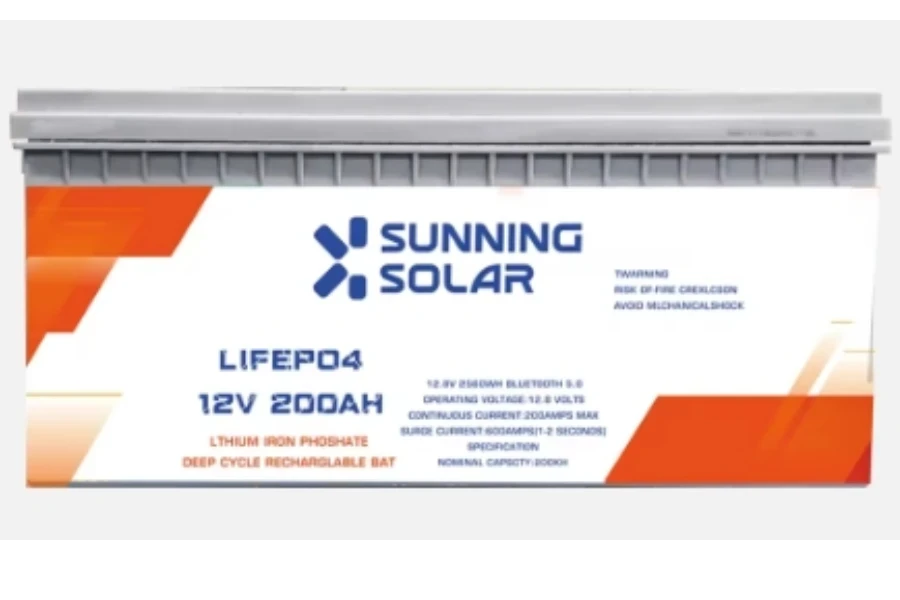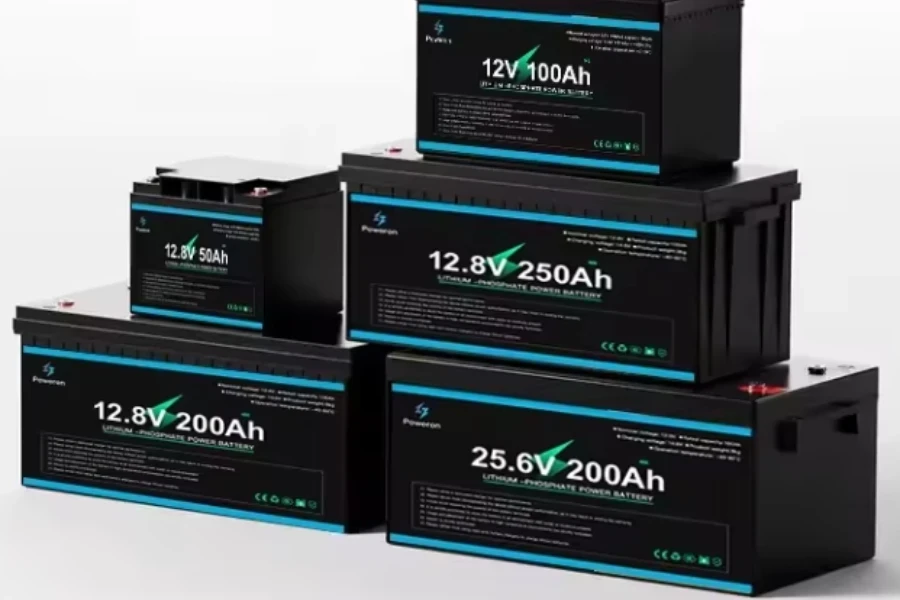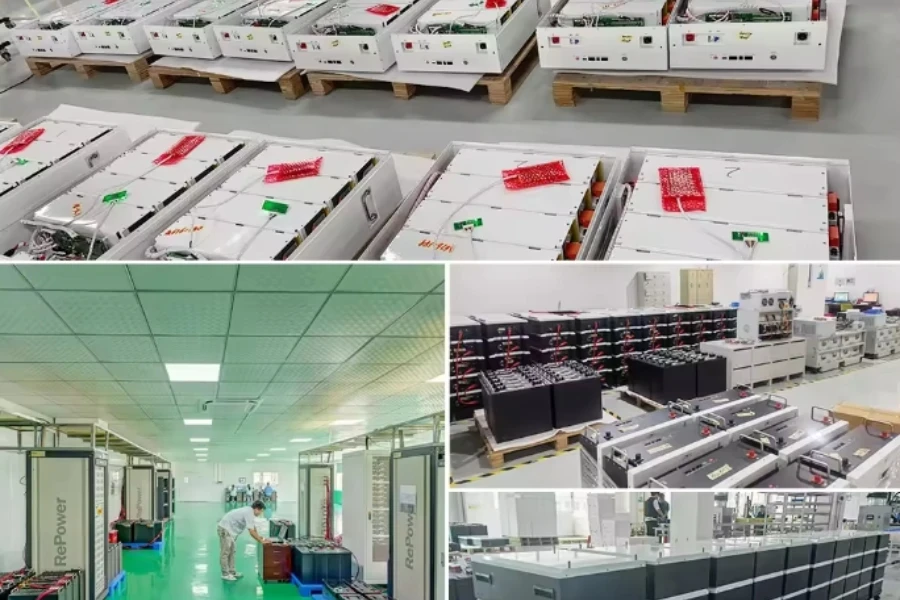LFP batteries are known for their robust safety features and long cycle life. These batteries consist of a lithium iron phosphate cathode material that is less susceptible to overheating, making them safer than conventional lithium-ion batteries. They are particularly suitable for applications requiring high load currents and high durability, such as electric buses and solar energy storage systems.
Read on for a brief overview of LFP batteries, and discover the key factors to consider when selecting LFP batteries in 2024.
Table of Contents
What is an LFP battery?
Composition
Classification
Application scenarios
What to consider when choosing an LFP battery?
Technology trends
The bottom line
What is an LFP battery?
Lithium-iron phosphate batteries (LFP batteries for short) are lithium-ion batteries that use lithium iron phosphate (LiFePO4) as the cathode material. Since their development in the early 2000s, LFP batteries have attracted widespread attention for their excellent thermal stability, long life, and environmental friendliness.
Compared to conventional lithium-ion batteries (e.g., those utilizing lithium cobalt oxide (LiCoO2)), LFP batteries exhibit significant advantages in terms of safety, cycle life, and cost-effectiveness, albeit at a relatively low energy density.
The structure of LFP batteries is such that they are less likely to initiate thermal runaway reactions under overcharging, short-circuiting, or high-temperature conditions, which greatly reduces the risk of fires or explosions, and makes them ideal for use in electric vehicles, energy storage systems, and portable devices.
This greatly reduces the risk of fire or explosion, making them ideal for applications such as electric vehicles, energy storage systems and portable electronic devices. LFP batteries are being used in an ever-expanding range of applications, from portable electronic devices to large electric vehicles to home and commercial energy storage systems.
Their long charge/discharge cycle life of 2,000 to 8,000 cycles is significantly higher than other types of lithium-ion batteries, meaning that LFP batteries offer a longer lifespan, which reduces long-term cost of ownership. In addition, LFP batteries do not contain hazardous substances such as cobalt and nickel, which makes them more environmentally friendly and easier to recycle.
Although the energy density of LFP batteries is lower than that of some other types of lithium-ion batteries, their excellent safety performance and economic benefits make LFP batteries a more reliable and sustainable choice for many applications.
Composition

Lithium-Fe-Phosphorus (LFP) batteries are composed of four key components: the positive electrode, the negative electrode, the electrolyte, and the diaphragm. These components work together to enable the battery to store and release electrical energy.
Cathode
The cathode material is lithium iron phosphate (LiFePO4). Advantages of this material include good thermal stability, long life and environmental friendliness. The crystal structure of lithium iron phosphate provides stable electrochemical performance and reduces the risk of overcharging, thus improving the overall safety of the battery.
Anode
The negative electrode of LFP batteries is usually made of graphite. During charging, lithium ions move from the positive electrode to the negative electrode and become embedded in the graphite layer; during discharging, lithium ions move from the graphite back to the positive electrode. The graphite anode provides a stable lithium storage environment for the battery, contributing to long-term cycling and efficient energy storage.
Electrolyte
The electrolyte acts as a transport medium for lithium ions in the battery, allowing lithium ions to move between the positive and negative electrodes during charging and discharging. The electrolyte in LFP batteries can be a liquid organic solvent with lithium salts (e.g., LiPF6) dissolved in it to provide good ionic conductivity.
Diaphragm
The diaphragm is a microporous film that sits between the positive and negative electrodes, preventing them from coming into direct contact and triggering a short circuit, while allowing lithium ions to pass through. The material and pore structure of the diaphragm have a significant impact on the ionic conductivity, safety and life of the battery.
Classification

LFP batteries are categorized primarily based on their application, form and battery management system, although they are relatively consistent in their chemical composition, i.e., they all use lithium iron phosphate as the cathode material. Below are a few common ways to categorize LFP batteries:
Categorized by application areas
Portable electronic devices: for cell phones, laptops, tablet PCs and other portable electronic products.
Electric transportation: for electric bicycles, electric cars, electric motorcycles and other transportation.
Energy storage systems: for solar photovoltaic systems, wind energy storage, home energy storage systems and large-scale grid energy storage solutions.
Industrial and commercial applications: including uninterruptible power supplies (UPS), emergency lighting, power tools and other industrial uses.
Categorized by form and size
Cylindrical batteries: Traditional cylindrical design for standardized battery needs.
Square or flexible pack batteries: offer more flexibility with customized shapes and sizes for specific equipment designs, suitable for space-constrained applications.
Large modules and batteries: Combine multiple individual batteries into large packs or modules for electric vehicles and energy storage systems.
Application scenarios

LFP batteries, with their safety and long-life characteristics, have been widely used in many fields. Below are a few of its main application scenarios and detailed descriptions:
Electric vehicles
LFP batteries are particularly popular in the electric vehicle sector because they offer excellent thermal stability and long life, reducing the frequency of battery replacement and lowering the long-term cost of ownership.
While the energy density of LFP batteries is lower than that of certain other types of lithium-ion batteries, they are sufficient for urban commuting and short-distance travel, while their high safety performance reduces the safety risks associated with the operation of electric vehicles.
Portable electronics
LFP batteries are also used in portable electronics such as cell phones, laptops, and digital cameras due to their high safety and stability. Although the devices in these applications often have high energy density requirements, the long life and low-maintenance characteristics of LFP batteries make them ideal for certain applications.
Energy storage systems
LFP batteries are an ideal solution for both home and commercial energy storage. They can efficiently store electricity generated by solar or wind energy for use at night or during periods of no wind. The high stability and long life of LFP batteries make them ideally suited for use as energy storage units in renewable energy systems, helping to increase energy efficiency and reduce grid dependency.
E-bikes and e-scooters
LFP batteries are widely used in lightweight electric transportation such as e-bikes and e-scooters due to their good weight-to-energy output, safety and cost-effectiveness. Compared to traditional lead-acid batteries, LFP batteries offer a lighter-weight solution that extends driving distances and reduces the number of recharges.
Solar street lighting and outdoor lighting
LFP batteries are also suitable for solar street lights and outdoor lighting systems that need to store enough energy for continuous illumination in the absence of solar input. The stability and long life of LFP batteries are particularly important in these applications, as they are often installed in areas that are difficult to maintain on a regular basis.
What to consider when choosing an LFP battery?

The following scenarios and factors should be considered when choosing lithium-ferrophosphorus (LFP) batteries as an energy solution:
High safety requirements
LFP batteries are an ideal choice if the application scenario requires extremely high battery safety, especially if there is a need to minimize the risk of fires and explosions caused by overcharging, overheating, or physical damage. LFP batteries are thermally and chemically stable, allowing them to maintain safe operation even under extreme conditions.
Long life requirements
For devices or systems that require long cycle life from their batteries, such as energy storage systems, electric transportation, and certain industrial applications, LFP batteries provide 2000 to 8000 charge/discharge cycles that far exceed those of many other types of lithium-ion batteries, dramatically extending battery replacement intervals and improving cost-effectiveness.
Outdoor or extreme environment applications
LFP batteries are able to operate stably over a wide temperature range, making them suitable for outdoor or temperature fluctuating environments. LFP batteries are an excellent choice for solar street lights, outdoor surveillance equipment, or equipment that needs to operate at high or low temperatures.
Cost sensitive items
While the initial purchase cost of LFP batteries may be higher than some other types of batteries (e.g., lead-acid batteries), their long lifespan and low maintenance requirements can provide a lower total cost of ownership over their entire lifespan. LFP batteries are a cost-effective option for projects with limited budgets but with long-term cost-effectiveness in mind.
Energy density is not a primary consideration
Although the energy density of LFP batteries is lower than that of some other types of lithium-ion batteries, if the application scenario does not have very stringent energy density requirements, the other benefits of LFP batteries (e.g., safety, longevity, and cost) may be more important.
Technology trends
LFP battery technology has shown a clear development trend in recent years, and the following are a few aspects of the development of LFP battery technology:
Improvement of energy density
Although LFP batteries have been favored for their safety and long life, their relatively low energy density limits their use in certain applications. Therefore, improving energy density has become one of the focuses of research and development.
By optimizing the microstructure of cathode materials and developing more efficient cell design and manufacturing techniques, researchers are working to increase the energy density of LFP batteries for a wider range of applications.
Cost reduction
LFP batteries are already popular in the market for their cost-effectiveness, especially when considering their long life and low maintenance costs. Continuing to reduce production costs is key to driving wider adoption of LFP batteries.
The industry is working to further reduce the overall cost of LFP batteries by improving production processes, realizing economies of scale in materials and manufacturing processes, and developing more efficient production technologies.
Fast charging technology
To improve the user experience, faster charging is another trend in the development of LFP battery technology. Researchers are exploring new electrolyte formulations and battery management systems (BMS) to support faster charging while ensuring battery safety and long life. This is especially important for applications such as electric vehicles that require fast charging.
The bottom line
LFP batteries are an important branch in the field of battery technology due to their outstanding safety, long service life and environmental friendliness. These batteries use lithium iron phosphate as the cathode material, providing stable chemistry and excellent thermal stability, making them a much lower safety risk under overcharging or high temperature conditions.
Although the energy density of LFP batteries is relatively low, their long life and low maintenance requirements make them highly cost-effective. Currently, LFP batteries are widely used in electric vehicles, portable electronic devices, energy storage systems, and many other fields.
In the future, with material innovation and continuous improvement in manufacturing technology, LFP batteries are expected to play a greater role in new applications. Finally, if you are interested in purchasing a LFP battery for your home or business, please visit this link.




